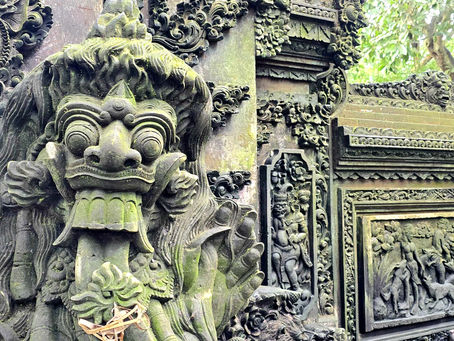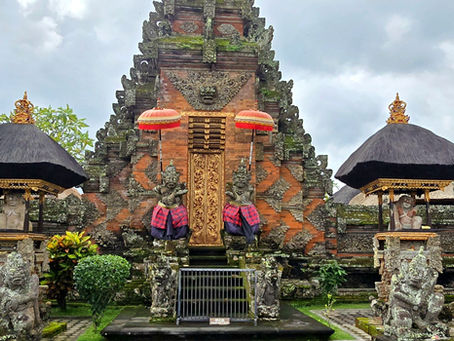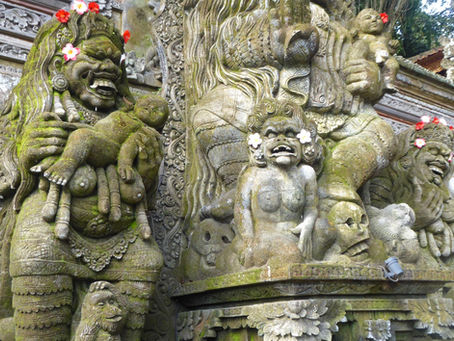top of page

GLOBAL SHANANIGANS

Search


Sacred Flames - Ubud’s Cremation Temple
Perched on the shadowed fringe of Ubud’s Sacred Monkey Forest, Pura Prajapati stands as a silent witness to centuries of life, death and the thin veil between them. Built around 1350AD, this moss cloaked cremation temple is one of the forest’s three ancient sanctuaries, yet its presence carries a weight far beyond stone and mortar.
Shannon


The Telaga Waja River
The Telaga Waja River, flowing down the verdant slopes of Mount Agung in East Bali, is best known today for its rafting adventures but beneath its rushing waters lies a deep, often overlooked historical and cultural undercurrent. Historically, this river has served as both a geographical and spiritual artery for the people of Karangasem. It provides water for rice fields through a traditional irrigation system called subak and many Balinese believe it to be sacred.
Shannon


The Great Temple of Death
Agung Padangtegal Temple is one of the primary temples located within the Sacred Monkey Forest Sanctuary in Ubud, Bali. Established in the late 14th century, the temple serves as a key spiritual site for the local community, dedicated primarily to the worship of Hindu deities and various ancestral spirits. It is considered the main temple of the forest complex and plays a central role in religious ceremonies.
Shannon


Goa Gajah Temple
Mystery surrounds the true origins of Goa Gajah, a 9th century cave temple complex near Ubud in central Bali. Rediscovered by Dutch archaeologists in 1923 after centuries hidden beneath dense vegetation, the site holds no actual link to elephants, despite its name. The term “Elephant Cave” likely evolved from Lwa Gajah, an old name associated with the nearby river, not from any animal symbolism found within the temple itself.
Shannon


The Moon of Pejeng - Temple of the Bronze Drum
Pura Penataran Sasih, founded in 1266 AD, was once the state temple of the Pejeng kingdom. Set in the fertile Petauan River valley, it reflects Bali’s ancient ties between ritual and agriculture. At its centre lies the Moon of Pejeng, a 2000 year old bronze drum and the largest single-cast of its kind in the world.
Shannon


Kajeng Rice Fields Loop
Slicing through glittering, gently terraced rice fields and fringed by towering coconut palms, the Kajeng Rice Fields Walk is arguably one of the prettiest treks you can do in the cultural capital of Ubud without a guide. Kajeng offers a rare and intimate glimpse into Bali’s traditional agricultural life, set against a landscape that’s both serene and alive with quiet purpose.
Shannon


Barong - King of the Good Spirits
Barong is one of the most iconic and revered figures in Balinese mythology, embodying health, good fortune and divine protection. More than just a mythical creature, Barong is believed to act as a guardian angel, accompanying each person through life and shielding them from harm. He is the leader of the hosts of good and the eternal nemesis of Rangda, the dreaded Widow Queen.
Shannon


The Royal Palace of Ubud
In the heart of Ubud, the Royal Palace stands as a stunning showcase of Bali’s rich history and artistic spirit. Built around 1640, this elegant complex of pavilions and gardens offers a glimpse into the lives of the island’s royal family while pulsating with cultural performances and traditional ceremonies that keep Ubud’s heritage alive.
Shannon


Campuhan Ridge Walk
On the Campuhan Ridge Walk, gentle paths wind past terraced rice fields, jungle valleys and scattered temples. It’s an effortless stroll, yet every step resonates with the echoes of centuries old Balinese culture.
Shannon


Sacred Monkey Forest Sanctuary
Hidden among dense jungle in Ubud, the Sacred Monkey Forest is a living tapestry of Balinese culture and nature. Ancient Hindu temples rise amid towering banyan trees, creating an atmosphere of quiet reverence. The forest invites visitors to step into a world where spiritual tradition, wildlife and natural beauty coexist seamlessly, offering a rare glimpse into Bali’s enduring heritage.
Shannon


Pura Dalem Ubud - The Temple of Death
In the shadowed heart of Ubud stands Pura Dalem, a temple steeped in ancient power and shadowed secrets. One of the area’s most formidable sacred sites, it pulses at the centre of the local spiritual life, a place where worship, dark rituals and otherworldly performances unfold. Its moss clad stone carvings depict guardian spirits and fearsome deities, whispering of life, death and the unseen forces that linger at the edge of perception.
Shannon


Gunung Kawi Tampaksiring - The Mountain of Lost Kings
Carved into the rock cliffs on both sides of the Pakrisan River, this 11th century temple site and funerary complex is of profound historical and spiritual significance to the Balinese people. The name Gunung Kawi translates to the "Mountain of Poetry" but it is also affectionately referred to as the Valley of the Kings.
Shannon


Ulu Petanu Waterfall
Tucked deep within Tegallalang village, Ulu Petanu Waterfall offers a peaceful, intimate retreat far from Bali’s busy tourist spots, where crystal-clear waters cascade gently amid dense jungle. Steeped in legend, it is also known as the sacred site linked to King Mayadenawa, whose blood is said to have cursed the nearby river, making the waterfall a place of spiritual cleansing and reverence.
Shannon


Batuan Temple
In the heart of Batuan village stands Pura Puseh Desa Batuan, one of Bali’s oldest and most spiritually charged temples. Founded in 1020 AD and recorded in Balinese historical texts for over a millennium, it is rooted in something far older, believed to have been built atop a megalithic stone circle, echoing the ancient power of Stonehenge, where ancestral rites were once performed.
Shannon


Gunung Lebah - The Birthplace of Ubud
Rising from the heart of Ubud, Gunung Lebah Temple was founded in the 8th century by the Indian priest Rsi Markandeya as a sanctuary for meditation and spiritual retreat. Nestled at the confluence of the Wos and Pakerisan rivers, where their waters merge to form the sacred Campuhan, the site hums with serene energy, surrounded by forests rich with medicinal plants believed to heal both body and soul.
Shannon


Tibumana Waterfall
Tucked away in the lush jungles of central Bali, Tibumana Waterfall is a serene escape that feels like stepping into a forgotten world. Unlike the more famous waterfalls of Bali, this hidden gem near Ubud remains relatively untouched, offering visitors a peaceful retreat surrounded by nature’s raw beauty.
Shannon


The Dark Legend of Calon Arang - Bali’s Most Feared Witch
In the black veins of Balinese and Javanese mythos, no figure evokes more dread than Calon Arang. Her story isn’t just about sorcery, it’s about what happens when society pushes a woman too far and she decides to burn the world down rather than be erased by it. She was no mere witch, she became the storm of death incarnate. The widow of Girah and the devourer of life.
Shannon


Ayung River Rafting - Bali's Scenic Waterway
The Ayung River is Bali’s longest waterway, stretching 68.5 km's from the lush northern highlands down to the southern coast at Sanur. It snakes its way through deep gorges, remote jungles, rice terraces and traditional villages, making it one of the island’s most scenic natural features. Despite its size, the Ayung maintains a gentle flow for much of its length, making it ideal for outdoor activities like rafting and river trekking.
Shannon


The Blanco Renaissance Museum
Perched on a ridge above Ubud’s sacred Campuhan River lies one of Bali’s most curious artistic enclaves, the Blanco Renaissance Museum, once the home and studio of the flamboyant artist Don Antonio Blanco. Often called the “Dali of Bali,” Blanco's vibrant persona and sensual art helped solidify his reputation as one of the island's most celebrated foreign creatives.
Shannon


Ubud Water Palace
Built in honour of its namesake Saraswati, the Hindu goddess of knowledge, music, art, wisdom and learning, Pura Taman Saraswati is a graceful water temple nestled in the heart of downtown Ubud. This sacred site blends spiritual reverence with classical Balinese aesthetics, offering a peaceful retreat just steps away from the town’s busy centre.
Shannon
bottom of page